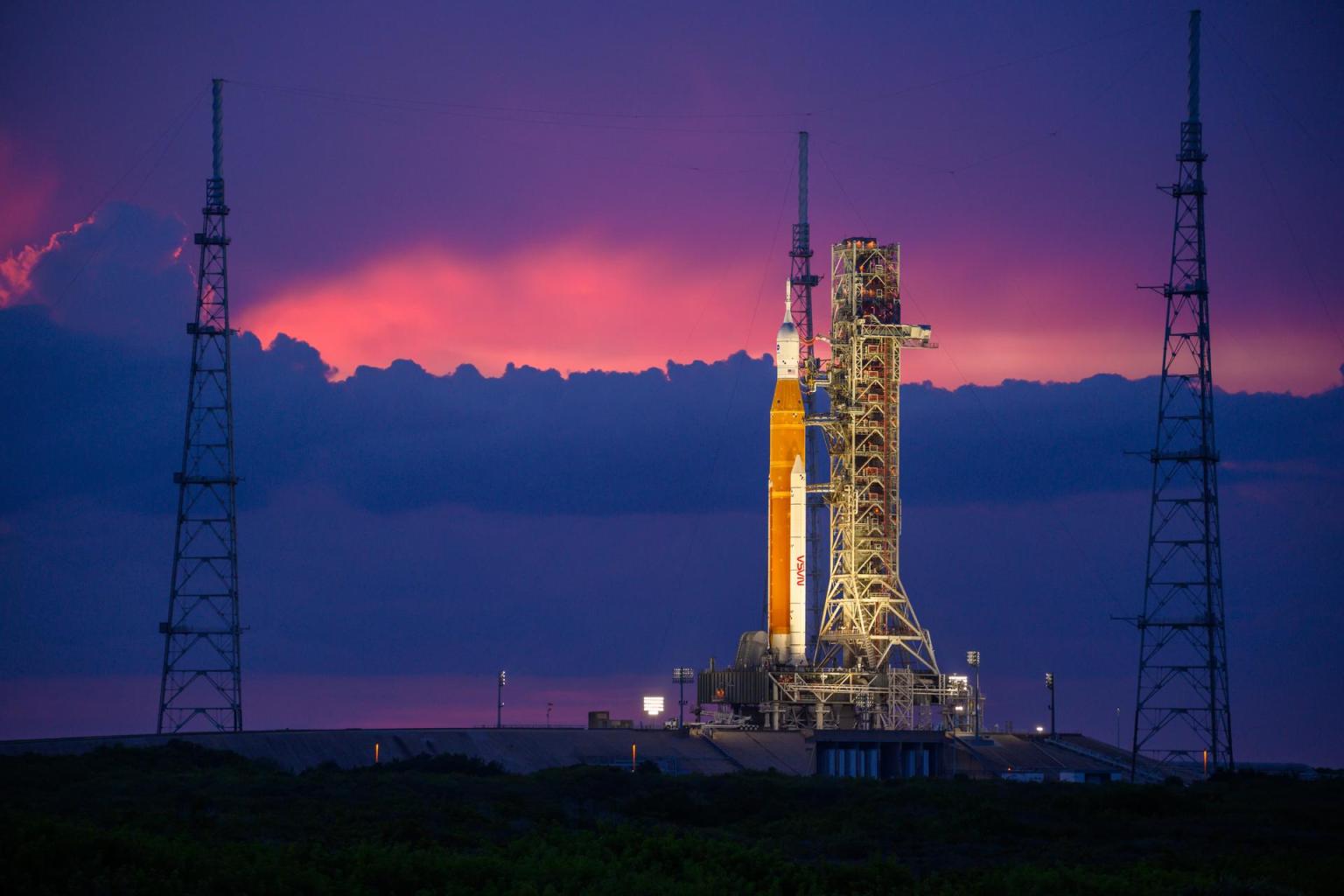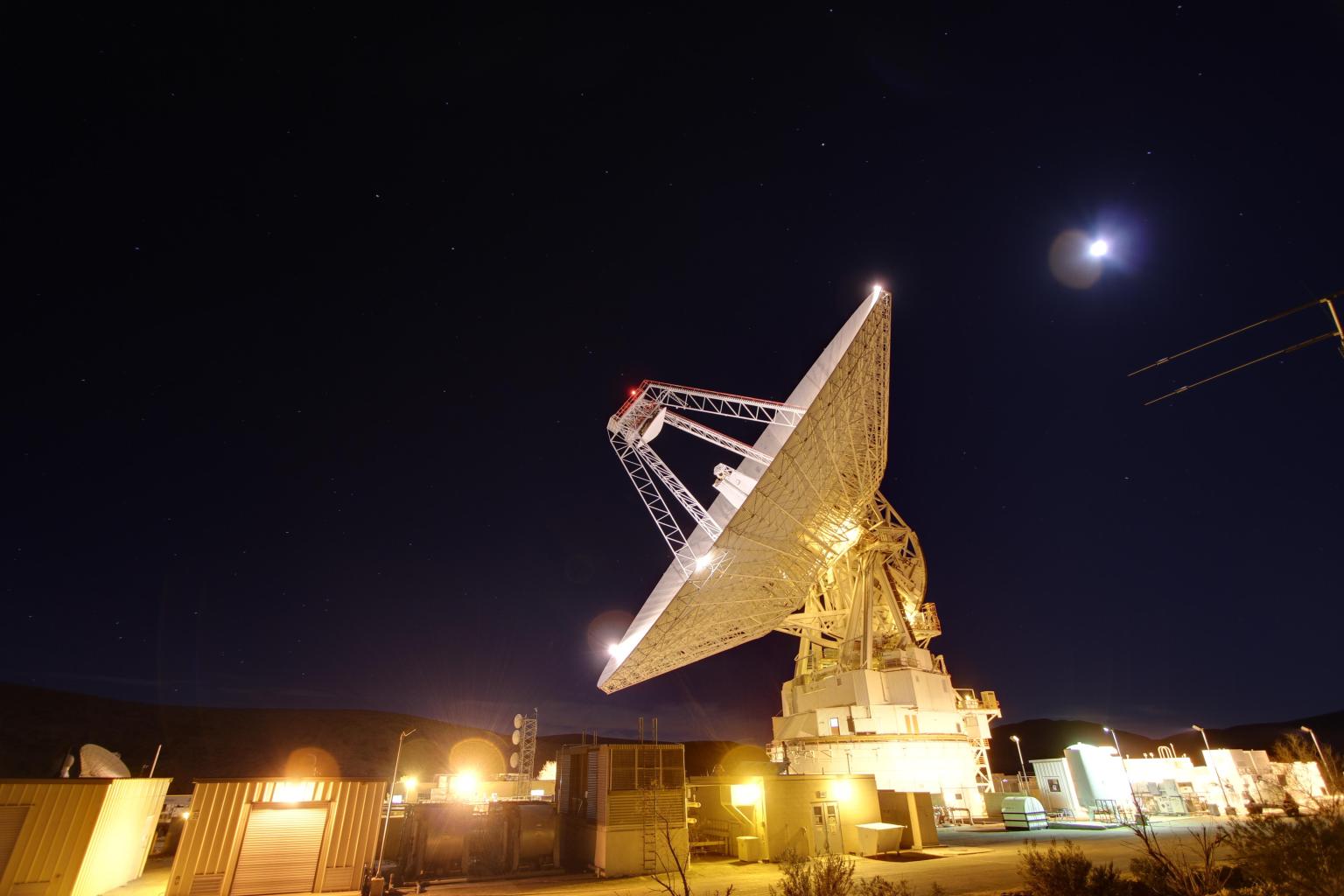Propulsion Test Capabilities
Air Force Research Laboratory
The Air Force Research Laboratory, formerly known as Phillips Laboratory, has extensive rocket propulsion facilities at Edwards Air Force Base, California. These facilities range from small scale cells capable of firing liquid rocket engines as small as 0.01 lbf (0.04 Newtons (N)) thrust up to very large liquid/solid test stands designed for firings up to 10 million lbf (44.5 million N) thrust.
AFRL Test Stand 1-14
Research rocket firing encompass both storable and cryogenic systems, ranging from ground level to simulated altitudes of 120,000 feet. Experiments are accomplished via a number of approaches, using any of five test cells for static testing of liquid propellant engines; dynamic load effects created by a centrifuge; or liquid propellant flow distribution measurements in the hydrodynamic flow lab. The solar Lab is housed in this complex, where Research and Development (R&D) is conducted on solar energy and hydrogen uses.
AFRL Test Area 1-32
Test Area 1-32 consist of four main facilities along with support facilities and explosive storage bunkers.
Pads 1 and 2 are designed to statically fire solid rocket motors at ambient pressures with thrust ratings up to one million pounds. The operating floor of the pad is 30 ft wide and 45 ft long.
Pad 3 is designed for hazardous operations involving BATES motors and operations that involve the detonation of explosive materials. This area consist of four reinforced concrete pads, each of which are 18 ft wide by 20 ft long and approx. 18 inches thick.
Pad 5 is designed to statically fire solid rocket motors at ambient pressures with thrust ratings up to 36,000 pounds. This area consist of three reinforced concrete pads, two of which are 10 ft wide by 20 ft long and one is 20 ft wide by 25 ft long.
AFRL Test Stand 1-36
Pad 1-36A is a bermed, horizontal position stand rated for thrusts up to 4,000,000 lbf, typically used for thrust determination, structural integrity, and destruct system evaluation. The pad is 260 feet long by 55 feet wide with floor thickness ranging from 3 to 20 feet.
Pad 1-36B is a vertical nozzle up facility rated for thrusts up to 4,000,000 lbf. The facility consists of two 30 foot by 95 foot high towers resting on a 12 foot thick concrete pad. The towers are designed for six component thrust measurement of 156 inch diameter motors.
Pad 1-36D is a 150 foot diameter decomposed granite pad designed to support a 120 inch diameter solid rocket propellant motor with up to 1,000,000 pounds on TNT equivalent propellant.
AFRL Test Stand 1-42
Area 1-42 is comprised of five test pads, a control blockhouse, a steam generation plant, a 1.4M gallon cooling water tower, a shop area and office trailers. The area has the capacity to store and transfer liquids and gases used in rocket motor research including LN2, LOX, LF2, MMH, N202, LH2, GHe, H2O, GN2 and propane. The steam generation plant has two banks of steam bottles and three sets of ejectors to provide altitude simulation to 100K ft.
The Vertical Test Cell (1-42B) is designed for testing bipropellant liquid rocket engines with up to 50K lbf of thrust at simulated altitude to 100K ft. Overall size of the chamber is 16 ft diameter by 28 ft high with a 16 ft diameter removable top cover.
The Space Environment Simulation Facility (1-42C) can perform static tests simulating space altitudes of up to 650K ft. The chamber is a 30 ft. diameter sphere capable of achieving 1 X 10-6 Torr at temperatures of -300F or +400F.
Horizontal Cell 1-42D can test solid rocket motors of up to 20K lbf thrust fired in a horizontal position at simulated altitude of 100K ft. Overall size of the chamber is 10-1/2 ft diameter by 25 ft in length.
The Exhaust Containment Facility (1-42E) is designed to provide an area capable of handling the build-up and testing of environmentally sensitive solid rocket motors at simulated altitudes up to 110K ft and 100K lbf of thrust. The motor cell is 40 ft long by 16 ft wide and can accommodate motors up to 30 inches diameter by up to 84 inches long.
AFRL Test Stand 1-56
Located in Area 1-56 are two rocket test positions with thrust capability of up to 10,000,000 lbf, the Shaft Preparation and Rocket Thrust (SPART) facility, two shop buildings, and a control center with offices.
The test pad can accommodate large engines or motors in a number of orientations. The pad is 100 by 200 ft with a vertical wall, inset in the side of a large granite butte at a 3,000 ft. elevation. The pad is unique in its ability to accommodate firings in the vertical (nozzle up), horizontal, or 15 degree positions.
AFRL Test Area 1-120
Area 1-120 consist of three liquid rocket stands, with five firing positions, a control center and various support facilities.
Vertical Stand 1A is a single position stand designed for 1,000,000 lbf thrust liquid rocket systems.
Vertical Stand 1B is a dual position stand designed for 6,000,000 lbf thrust liquid rocket systems.
Stand 2A is a two-position horizontal stand designed for 460,000 lbf thrust LOX/LH2 component stand.
AFRL Test Area 1-125
Test Area 1-125 consist of three large rocket stands and necessary support structures and equipment.
Test Stand 1C is configured with a six-axis system for measuring thrust from a solid rocket motor of up to 1.6 million lbf in the x-axis (vertical) and 200,000 lbf in the y-axis (horizontal).
Test Stand 1D is capable of thrust measurement uo to 2.5 million lbf of thrust, with four degrees of freedom and hydraulic calibration.
Test Stand 1E, originally with the same characteristics of Stand 1D, is the location of the National Hover Test Facility (NHTF). The NHTF consist of a high bay hover and flight volume with adjacent control room, a target test stand, a vehicle integration facility with clean room, and areas for loading, servicing, and decontaminating propellants from test vehicles. The facility contains independent propellant storage and handling capabilities, computer controlled mirrored satellite tracking pedestal for location and tracking satellite targets, and stand-alone telemetry systems.
































